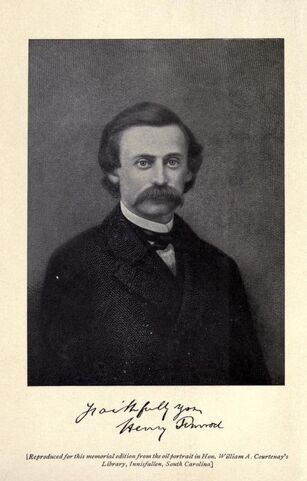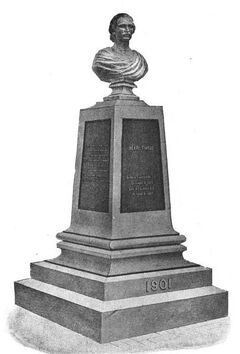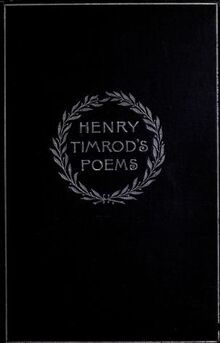
Henry Timrod (1828-1867), from The Poems of Henry Timrod, 1899. Courtesy Internet Archive.
| Henry Timrod | |
|---|---|
| Born |
December 8, 1828 Charleston, South Carolina |
| Died |
October 7, 1867 (aged 38) Columbia, South Carolina |
| Citizenship |
|
Henry Timrod (December 8, 1828 - October 7, 1867) was an American poet, often called the poet laureate of the Confederacy.
Life[]
Overview[]
Timrod, born at Charleston, South Carolina, of German descent, was ruined by the Civil War, and died in poverty. He wrote a volume of poems, published 1860, which attained wide popularity in the South. He had notable descriptive power.[1]
Youth and education[]
Timrod was born in Charleston, South Carolina, to a family of German descent. (The family's original surname was "Dimroth".) His father was an officer in the Seminole Wars and a poet himself. Timrod studied at the University of Georgia, but, forced by illness to end his formal studies, returned to Charleston.
Career[]
He took a position with a lawyer and planned to begin a law practice. From 1848 to 1853 he submitted a number of poems to the Southern Literary Messenger under the pen name Aglaus, where he attracted some attention for his abilities. Encouraged, he left the field of law for writing and tutoring.
In 1856 he accepted a post as a teacher at the plantation of Col. William Henry Cannon in the area that would later become Florence, South Carolina. The single-room school building (still preserved in Timrod Park in Florence) was built to provide for the education of the plantation children. Among his students was the young lady who would later become his bride and the object of a number of his poems - the "fair Saxon" Katie Godwin.
While teaching and tutoring he continued also to publish his poems in literary magazines. In 1860, he published a small book, which, although a commercial failure, increased his fame. The best-known poem from the book was "A Vision of Poesy".
With the outbreak of American Civil War, Henry returned to Charleston, soon publishing his best-known poems, which drew many young men to enlist in the service of the Confederacy. His best-known poems of the time are "Ethnogenesis", "A Cry to Arms", "Carolina" and "Katie." He was a frequent contributor of poems to Russell's Magazine and to The Southern Literary Messenger.
Timrod soon followed into the military as a private in Company B, 20th South Carolina Infantry, but illness prevented much service, and he was sent home. After the bloody Battle of Shiloh, he tried again to live the camp life as a western war correspondent for the Charleston Mercury, but this too was short lived as he was not strong enough for the rugged task.
He returned from the front and settled in Columbia, to become associate editor of the newspaper, The South Carolinian. In February 1864 he married his beloved Katie, and they soon had a son, Willie, born on Christmas Eve. During the occupation by General Sherman's troops in February 1865, he was forced into hiding, and the newspaper office was destroyed.
The aftermath of war brought his family poverty and to him, increasing illness. He took a post as correspondent for a new newspaper based in Charleston, The Carolinian, but after several months of work he was never paid and the paper folded. His son Willie soon died, and Henry was to join him in death, of consumption, in 1867.
He is interred in the churchyard at [Trinity Episcopal Church in Columbia.
Writing[]
Timrod's friend and fellow poet, Paul Hamilton Hayne, posthumously edited and published The Poems of Henry Timrod, with more of Timrod's more famous poems in 1873, including his "Ode: Sung on the Occasion of Decorating the Graves of the Confederate Dead at Magnolia Cemetery, Charleston, S.C., 1867" and "The Cotton Boll".
Later critics of Timrod's writings, including Edd Winfield Parks and Guy A. Cardwell, Jr. of the University of Georgia, Jay B. Hubbell of Vanderbilt University and Christina Murphy, who completed a Ph.D. dissertation on Timrod at the University of Connecticut, have indicated that Timrod was one of the most important regional poets of nineteenth-century America and one of the most important Southern poets. In terms of achievement, Timrod is often compared to Sidney Lanier and John Greenleaf Whittier as poets who achieved significant stature by combining lyricism with a poetic capacity for nationalism. All three poets also explored the heroic ode as a poetic form.

Henry Timrod memorial, Washington Park, Charleston. From Henry Timrod, Man and Poet: A critical study, 1915. Courtesy Wikimedia Commons.
Recognition[]
Today, Timrod's poetry is included in most of the historical anthologies of American poetry, and he is regarded as a significant (though secondary) figure in 19th-century American literature.
In 1901, a monument with a bronze bust of Timrod was dedicated in Washington Park, Charleston.
Perhaps a greater honor was given to him when the state's General Assembly passed a resolution in 1911 instituting the verses of his poem "Carolina" as the lyrics of the official state anthem.
In popular culture[]
In September 2006 an article for The New York Times noted similarities between Bob Dylan's lyrics in the album, Modern Times and the poetry of Timrod. A wider debate developed in The Times as to the nature of "borrowing" within the folk tradition and in literature.[2][3][4]
Publications[]
Poetry[]
- Poems. Boston: Ticknor & Fields, 1860.
- Poems (edited by Paul Hamilton Hayne). New York: E.J. Hale, 1872.
- Katie. New York: E.J. Hale, 1884.
- Poems; with memoir and portrait. Boston: Houghton, Mifflin, 1899; Richmond, VA: B.F. Johnston, 1901.
- Verses from The Cotton Boll. Boston: Stillings Press, 1901.
- Uncollected Poems (edited by Guy A. Cardwell Jr.). Athens, GA: University of Georgia Press, 1942.
- Collected Poems: A variorum edition (edited by Edd Winfield Parks & Aileen Wells Parks). Athens, GA: University of Georgia Press, 1965.
Non-fiction[]
- Essays (edited by Edd Winfield Parks). Athens, GA: University of Georgia Press, 1942.
Letters[]
- "Some Letters of Henry Timrod" (edited by Thomas O. Mabbott), American Collector 3 (February 1927): 191-195.
- "Unpublished Letters of Henry Timrod" (edited by William Fidler), Southern Literary Messenger 2 (October 1940): 527-535; (November 1940): 605-611; (December 1940): 645-651.
- Last Years of Henry Timrod, 1864-1867: Including letters of Timrod to Paul Hamilton Hayne and letters about Timrod by William Gilmore Simms, John R. Thompson, John Greenleaf Whittier, and others (edited by Jay B. Hubbell). Durham, NC: Duke University Press, 1941.
- "Seven Unpublished Letters of Henry Timrod" (edited by Fidler). Alabama Review 2 (April 1949): 139-149.
- "Two Timrod Letters" (edited by Douglas J. Robillard). North Carolina Review 39 (Autumn 1962): 549- 553.
Except where noted, bibliographical information courtesy the Poetry Foundation.[5]

"Ode" by Henry Timrod
See also[]
References[]
- Cisco, Walter Brian, Henry Timrod: A biography. Fairleigh Dickinson University Press, 2004, ISBN 0-8386-4041-9.
Notes[]
- ↑ John William Cousin, "Timrod, Henry," A Short Biographical Dictionary of English Literature. London: Dent / New York: Dutton, 1910, 382. Wikisource, Web, Mar. 13, 2018.
- ↑ Rich, Motoko (2006-09-14). ""Who's This Guy Dylan Who's Borrowing Lines From Henry Timrod?"". The New York Times. http://www.nytimes.com/2006/09/14/arts/music/14dyla.html?ref=books. Retrieved 2006-09-19.
- ↑ Vega, Suzanne (2006-09-17). ""The Ballad of Henry Timrod". The New York Times. http://www.nytimes.com/2006/09/17/opinion/17vega.html?n=Top%2fReference%2fTimes%20Topics%2fPeople%2fD%2fDylan%2c%20Bob. Retrieved 2006-09-20.
- ↑ ""The Answer, My Friend, Is Borrowin' ... (3 Letters)". The New York Times. 2006-09-20. http://www.nytimes.com/2006/09/20/opinion/l20dylan.html. Retrieved 2006-09-20.
- ↑ Henry Timrod 1828-1867, Poetry Foundation. Web, Dec. 19, 2012.
External links[]
- Poems
- "A Summer Shower"
- Henry Timrod's "Cotton Boll", Cotton Boll Conspiracy, May 27, 2011]
- Henry Timrod 1828-1867 at the Poetry Foundation
- Henry Timrod (1829-1867) at Sonnet Central (15 sonnets)
- Henry Timrod at My Poetic Side
- Henry Timrod at PoemHunter (94 poems)
- Henry Timrod at Poetry Nook (117 poems)
- Audio / video
- Books
- Poems electronic edition
- Works by Henry Timrod at Project Gutenberg
- Works by Henry Timrod at Internet Archive
- Henry Timrod at Amazon.com
- About
- Henry Timrod in the Encyclopædia Britannica
- review of Henry Timrod: A biography at Fairleigh Dickinson University
- Henry Timrod at PBS
- Henry Timrod: A biography by Walter Brian Cisco (limited preview)
- "Bob Dylan: Henry Timrod revisited" at the Poetry Foundation
| This page uses Creative Commons Licensed content from Wikipedia. (view article). (view authors). |
| This page uses content from Wikinfo . The original article was at Wikinfo:Henry Timrod. The list of authors can be seen in the (view authors). page history. The text of this Wikinfo article is available under the GNU Free Documentation License and the Creative Commons Attribution-Share Alike 3.0 license. |
|
